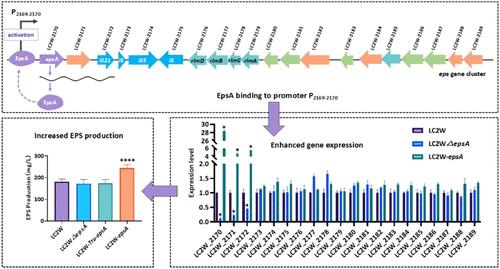LytR Family Transcriptional Regulator EpsA Positively Regulates Exopolysaccharide Biosynthesis in Lacticaseibacillus casei
IF 6.2
1区 农林科学
Q1 AGRICULTURE, MULTIDISCIPLINARY
引用次数: 0
Abstract
Exopolysaccharides (EPSs) produced by Lacticaseibacillus casei have great potential for application in the food industry. However, the transcriptional regulation of EPS biosynthesis in L. casei remains unclear. Here, the transcription profile of the eps gene cluster was characterized in L. casei. Co-transcriptional analysis suggested that EPSs harbor three operons controlled by promoters P2169–2170, P2185–2186, and P2189–2190, respectively. Electrophoretic mobility shift assay showed that EpsA, the sole transcriptional regulator in the eps gene cluster, directly binds promoters P2169–2170 and P2189–2190. Overexpression of epsA increased the EPS titer (243.60 mg/L) with significantly enhanced expression of three eps genes, suggesting EpsA as a transcriptional activator for EPS biosynthesis. Furthermore, RNA-seq analysis revealed that 67 genes were significantly changed with the epsA knockout, especially 16 genes associated with EPS biosynthesis. This indicated that EpsA may be a global/pleiotropic regulator. Collectively, our findings lay the foundation for elucidating the transcriptional regulation of EPS biosynthesis in L. casei.

LytR家族转录调节因子EpsA正调控干酪乳杆菌胞外多糖的生物合成
干酪乳杆菌(lactoaseibacillus casei)生产的胞外多糖(EPSs)在食品工业中具有巨大的应用潜力。然而,干酪乳杆菌EPS生物合成的转录调控尚不清楚。本文对干酪乳杆菌中eps基因簇的转录谱进行了分析。共转录分析表明,eps含有三个由启动子P2169-2170、P2185-2186和P2189-2190控制的操作子。电泳迁移位移分析表明,EpsA是eps基因簇中唯一的转录调控因子,可直接结合启动子P2169-2170和P2189-2190。epsA过表达后EPS滴度升高(243.60 mg/L), 3个EPS基因的表达量显著增加,提示epsA可能是EPS生物合成的转录激活因子。此外,RNA-seq分析显示,epsA基因敲除后,67个基因发生了显著变化,尤其是与EPS生物合成相关的16个基因。这表明EpsA可能是一种全局/多效性调节剂。总之,我们的发现为阐明干酪乳杆菌EPS生物合成的转录调控奠定了基础。
本文章由计算机程序翻译,如有差异,请以英文原文为准。
求助全文
约1分钟内获得全文
求助全文
来源期刊
CiteScore
9.90
自引率
8.20%
发文量
1375
审稿时长
2.3 months
期刊介绍:
The Journal of Agricultural and Food Chemistry publishes high-quality, cutting edge original research representing complete studies and research advances dealing with the chemistry and biochemistry of agriculture and food. The Journal also encourages papers with chemistry and/or biochemistry as a major component combined with biological/sensory/nutritional/toxicological evaluation related to agriculture and/or food.

 求助内容:
求助内容: 应助结果提醒方式:
应助结果提醒方式:


